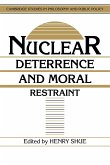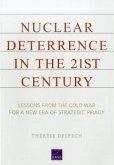An important and timely contribution to International Relations and political science, this is the first general analysis of deterrence since the end of the Cold War. Using non-cooperative game theory, the authors develop a new approach to deterrence (Perfect Deterrence Theory), which they apply to unilateral and mutual direct-deterrence relationships, and to extended-deterrence relationships supported by deployment policies such as Massive Retaliation and Flexible Response. The authors focus on the relationship among capabilities, preferences, credibility, and outcomes to achieve a new understanding of threats and responses. Some surprising conclusions emerge, indicating that credible threats to respond to attack can sometimes make an attack more likely, and that incredible response threats can sometimes promote peace. With the application of deterrence theory in diverse social settings, and historical examples from before, during, and after the Cold War, this book provides a welcome new examination of the subject.
Table of contents:
Part I. Theoretical Underpinnings: 1. Classical deterrence theory; 2. Rationality and deterrence; 3. Credibility: the magic ingredient of deterrence; Part II. Direct Deterrence: 4. Uncertainty and mutual deterrence; 5. Unilateral deterrence; Part III. Extended Deterrence: 6. Extended deterrence; 7. Modeling massive retaliation; 8. Modeling flexible response; 9. Crisis, escalation, and limited war; Part IV. Implications: 10. Perfect deterrence theory.
This book provides the first general analysis of deterrence since the end of the Cold War, offering a new approach to its assumptions, and analyzing them using game theory. Drawing on numerous historical examples, the authors' analysis provides a new understanding of threats and responses, and yields some surprising conclusions.
The first general analysis of deterrence since the Cold War, using game theory and containing numerous historical examples.
Hinweis: Dieser Artikel kann nur an eine deutsche Lieferadresse ausgeliefert werden.
Table of contents:
Part I. Theoretical Underpinnings: 1. Classical deterrence theory; 2. Rationality and deterrence; 3. Credibility: the magic ingredient of deterrence; Part II. Direct Deterrence: 4. Uncertainty and mutual deterrence; 5. Unilateral deterrence; Part III. Extended Deterrence: 6. Extended deterrence; 7. Modeling massive retaliation; 8. Modeling flexible response; 9. Crisis, escalation, and limited war; Part IV. Implications: 10. Perfect deterrence theory.
This book provides the first general analysis of deterrence since the end of the Cold War, offering a new approach to its assumptions, and analyzing them using game theory. Drawing on numerous historical examples, the authors' analysis provides a new understanding of threats and responses, and yields some surprising conclusions.
The first general analysis of deterrence since the Cold War, using game theory and containing numerous historical examples.
Hinweis: Dieser Artikel kann nur an eine deutsche Lieferadresse ausgeliefert werden.








